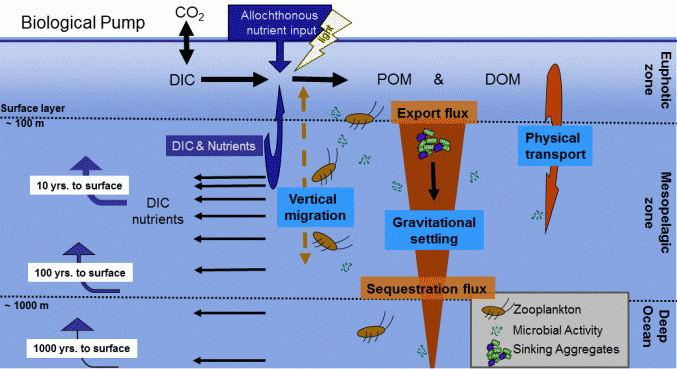Photosynthesis, e.g. the fixation of inorganic carbon by phytoplankton (tiny, one celled plants) in the upper ocean determines the production of organic matter. Some of this material, e.g. organisms, feces and detritus form what we call marine snow. Marine snow are the dust bunnies of the ocean. Formation of marine snow via aggregation or via zooplankton activity determines the sinking of organic carbon from the surface layer, because marine snow sinks at 100 m d-1 or more, whereas individually small particles sink with only 1 m d-1. During transit bacterial degradation or grazing by zooplankton reduce the amount of organic matter that sinks. Dissolution of inorganic bio-minerals reduces the downward flux of inorganic matter. Continuous aggregation and fragmentation additionally impact sedimentation through the ocean. The term “biological carbon pump” describes all these processes taken together as they determine the transport of carbon from the surface of the ocean to it's depth, thereby removing carbon from the atmosphere for long periods of time. To date, the oceans have taken up ⅓ to ¼ of the carbon released by fossil-fuel burning. The rate of increase of atmospheric CO2 concentrations will depend on, among other things, the effectiveness of the biological carbon pump in the future. See a brief movie on the Biological Pump.
During EXPORTS, a large field program with funding from NASA and NSF, our lab will investigate marine snow in the ocean. Marine snow is defined as composite particles > 0.5 mm. Because marine snow is relatively large – compared to algae and small zooplankton – it sinks at appreciably speed to depth. Marine snow is thus responsible for a very large fraction of the material that sinks into the deep ocean, where it provides food to many animals. The sinking of carbon is almost extremely important for the cycling of carbon, and sequestration of anthropogenic carbon. Because marine snow is relatively large, it is also much rarer than most plankton and it is often very fragile. Thus marine snow can’t be sampled with standard oceanographic methods, like Niskin bottles. During the cruise in August 2018 we will use a marine snow catcher (MSC), a large sampling device collecting 100 liter of water at a designated depth. Once this large water sampler is onboard the ship, it will rest for about 2 hours to give sinking marine snow the opportunity to sink into the bottom part of the 2-meter high water sampler. Then “non-sinking” particles will be subsampled from the upper part of the MSC, and sinking particles may be sampled from the lower part. Because of its size, marine snow can be manually collected from this lower part. The collected particles will be used to determine their characteristics, e.g. their carbon content, their size and composition, their degradation rate or the bacterial activity. Marine snow is considered a hot spot of activity, as many organisms live on these particles.
Will the ocean continue to store part of the carbon?
How will the ongoing changes, and especially ocean acidification, effect the biological pump and the oceans themselves?
Under what conditions does the biological pump transport oil to deeper water?
If you would like to learn more about the biological pump read Bathmann & Passow

